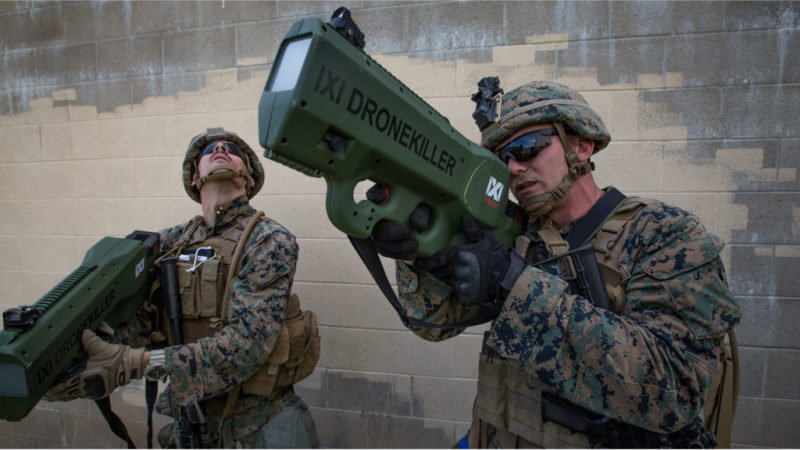Pentagon green-lights counter-drone strategy amid 'urgent' threat
By: Noah Robertson (Defense News)


Never let a crisis go to waste. The brass hats are on the ball, creating a multi-tiered plan to scrape as much money off taxpayers as possible.
Mission accomplished!

Defense Secretary Lloyd Austin signed off on a classified strategy Monday for countering drone threats in an effort to unify the military's approach to protecting its facilities and personnel from weaponized unmanned aerial systems.
"Unmanned systems pose both an urgent and enduring threat to U.S. personnel, facilities, and assets overseas," the Pentagon said in a statement Thursday announcing the strategy. "By producing a singular Strategy for Countering Unmanned Systems, the Secretary and the Department are orienting around a common understanding of the challenge and a shared approach to addressing it."
One-way aerial drone attacks have spiked in recent years, and the Pentagon has grown increasingly concerned by the threats they pose to the U.S. and its allies. For more than a year, Iran-backed Houthi rebel groups have been using small unmanned aerial systems, or UAS, to target ships in the Red Sea, and killer drones have featured heavily in Russia's war in Ukraine.
DOD officials have said the department is taking a layered approach to defending against enemy drones, meaning the U.S. will pursue a range of capabilities to disable these systems, from electronic warfare to kinetic weapons. The military services have a number of ongoing programs to develop and field this technology.
Austin's strategy is aligned with these and other high-level DOD efforts, including those led by the Joint Counter-Small UAS office, which was established in 2019 to coordinate counter-UAS development, tactics and training across the military services.
The strategy also closely follows the second phase of Replicator, which is focused on rapidly fielding off-the-shelf counter-drone technology. Austin, who announced Replicator 2 in September, said the Pentagon plans to request funding in fiscal 2026 and set a two-year timeline for delivering "meaningfully improved" counter-UAS systems.
An unclassified fact sheet released Thursday sheds some light on the department's strategy, laying out five lines of effort it plans to pursue. These include: improving its ability to detect, track and characterize counter-drone threats; launching focused campaigns to counter "threat networks"; making counter-drone defense a core piece of its doctrine, training and policy; quickly fielding counter-UAS technology and prioritizing funding for these capabilities; and placing a greater emphasis on countering unmanned systems in its force development and design efforts.
The strategy emphasizes the need for partnerships with Congress, defense and commercial industries and allies. It also pledges to create clear metrics to track its progress, though it's unclear if those details will be publicly released.
"This strategy marks a critical next step in the Department of Defense's efforts to counter unmanned systems, but much work lies ahead," the fact sheet states. "Although the rapidly evolving nature of the threats posed by adversary use of unmanned systems means that the department will need to continually reassess our efforts, this strategy sets a foundation for action to meet this challenge."
Courtney Albon is C4ISRNET's space and emerging technology reporter. She has covered the U.S. military since 2012, with a focus on the Air Force and Space Force. She has reported on some of the Defense Department's most significant acquisition, budget and policy challenges.
Noah Robertson is the Pentagon reporter at Defense News. He previously covered national security for the Christian Science Monitor. He holds a bachelor's degree in English and government from the College of William & Mary in his hometown of Williamsburg, Virginia.

Tags
Who is online
49 visitors


Aren't these to guys that allowed a balloon to float across the United States, shot it down with an defense mission that cost a lot more than the balloon, and then spent two weeks trying find the thing in shallow water?
You're in good hands with military Bloatstate insurance. Every time there's a crisis, the taxpayers send money to the Bloatstate insurance company. But, hey, we get great halftime shows at the football games.
You mean the balloon that was identified as a Chinese spy balloon? Then shot down once it reached a location where it would not damage any people or property? That balloon?
What crisis? These drones do not appear to have even violated a law at this point.
He means the Chinese spy balloon that the Brandon administration knew about when it entered Alaskan air space and tracked it all the way across Canada and into the US.
Brandon could have shot it down during any of that time period w/o any risk to life and property. The areas the balloon traveled were some of the most remote around.
Funny how concerns about life and property didn't stop him from downing real weather balloons (school projects) after that all over he US and Canada.
Correct, the balloon that was identified as a Chinese spy balloon, then shot down once it reached a location where it would not damage any people or property.
You thought Biden should have gone out there and taken pot shots at it with a rifle? Seriously????
1st, bullshit.
2nd, what was being carried by the balloon? We know now, but had no idea at the time. It was shot down once it left the coast.
You mean the spy balloon that was not spying?
The government used the media to sensationalize the event but didn't actually do anything. The balloon was allowed to drift from border to border, unmolested, because the balloon couldn't navigate. The military shot down the balloon after it had crossed the country using military hardware that cost orders of magnitude more than the balloon. Then the military expended weeks attempting to find and recover the balloon in shallow water. Never let a crisis go to waste. The military argued for funding new weapons capability. Political government argued for retaliatory action against China. The media argued that it had been correct all along. History shows that the balloon was pretty much what the Chinese had said it was.
The public has concerns. The governmental response has been to dodge and dance. The bureaucratic attitude on display has that the public are just stupid ignorant idiots and their concerns can be ignored.
So what?
Again, no crime is being committed by the drones. Not much the government can do about it without infringing on the drone owners' Constitutional rights.
Again, the drones are doing nothing that constitutes a crime, therefore the government can't do anything.
Please describe in detail and site the article and paragraph in the constitution that covers "drone Owners" constitutional rights.
Have you taken any kind of American government class in your life? Even at an elementary school level?
Knocking down drones that are not committing any crimes with their presence would be a "seizure" of the owner's personal property. AND AGAIN, since those drones are not violating any laws, that seizure would be UNCONSTITUTIONAL .
Feel free to fly your drone over my house. Target practice: PULL!
[✘]